Places to Visit in New Delhi:
Rashtrapati Bhavan: When in New Delhi, don’t miss out on exploring the Rashtrapati Bhavan, the official residence of the President of India. Flanked on the western end of the Rajpath, this sprawling 330-acre estate houses the Main Building (Circuit 1), the Rashtrapati Bhavan Museum Complex (Circuit 2), and the world-famous Mughal Gardens (Circuit 3). A creation of Sir Edwin Lutyens and Herbert Baker, this huge presidential palace is the largest home of any head of state in the world and is truly an architectural marvel.
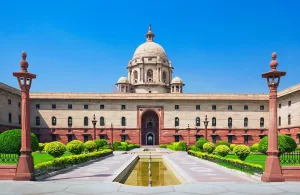
India Gate: India Gate symbolizes the sacrifice of 70,000 Indian soldiers who lost their lives battling against the foreign army during World War I. Designed by Edwin Lutyens, it features the undying Amar Jawan Jyoti or the Flame of the Immortal Soldier, which was added later to honor Indian martyred soldiers in the Indo-Pak War. Furthermore, this beautiful masterpiece is counted among the largest war memorials in India. Standing on a Bharatpur stone base, the structure is surrounded by lush lawns making it a popular picnic spot during winter afternoons and summer evenings. Lit at night, the monument looks magnificent, with colorful fountains nearby.
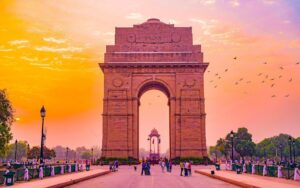
Qutub Minar: Qutub Minar is a 73-meter tall minaret named after Qutb-ud-din Aibak. The tower contains five distinct tapering stories, wherein the first 3 stories of this masterpiece are adorned with red sandstone, while the fourth and fifth stories are constructed in marble and sandstone, respectively, engraved with decorative Quranic texts. Interestingly, the tower has a spiral staircase with 379 steps and has a mosque named ‘Quwwat-ul-Islam Masjid’ at the foot of the tower, which is the first mosque in India.
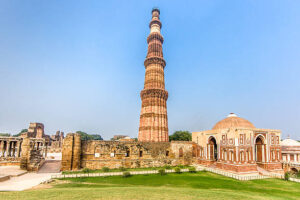
Red Fort: Constructed in 1639 by the Mughals, Red Fort gets its name from its massive red-colored sandstone walls. Set in Old Delhi, the octagonal-shaped fort is spread over 254 acres. The planning and designing of the fort is a fusion of Mughal, Persian, Hindu, and Timurid traditions. A strong influence on later structures built in and around Delhi, Red Fort also features a museum with Mughal-era artifacts, including daggers, curtains, miniature paintings, and carpets. The highlights of this architectural creativity include the peacock throne, step well, imperial bath, Moti Masjid, and Hira Mahal.

Akshardham Temple: Dedicated to Bhagwan Swaminarayan, Akshardham Temple exhibits India’s ancient culture. The temple complex maintains a step-well-styled courtyard and 60 acres of lush lawns featuring the bronze statues of Indian heroes, including patriots and warriors. Registered as the World’s largest comprehensive Hindu temple in the Guinness World Record, the temple is an architectural marvel built from intricately carved sandstone and marble. Furthermore, the temple organizes exhibitions on Swaminarayan’s life teachings and organises a musical fountain and light show after sunset every day.
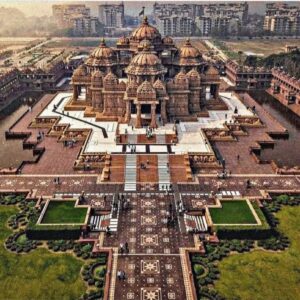
Hauz Khas: Earlier known as Hauz-e-Alai, this affluent neighborhood in South Delhi holds historical importance with remnants of Mughal architecture. The place is famous for a 13-century structure, Hauz Khas Complex, which retains the old charm amidst the modernized street. Besides raving it up at an urban village in Delhi, we suggest you take delight in the greenery of Deer Park, splurge at designer label boutiques and admire the fine artwork at various art galleries.
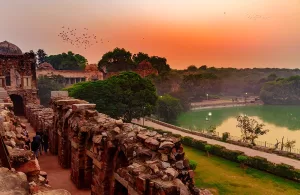
Dilli Haat: An outdoor marketplace located near INA Market, Dilli Haat is a permanent bazaar run by the Delhi Tourism and Transportation Development Corporation. It has over 62 stalls presenting handicrafts ranging from antiques to jewelry, clothing, home furnishings, and toys. The traditional rural ambiance is backed by multiple food kiosks to keep your tummy full anytime you go. Dilli Haat also organizes many cultural events, including dance and music performances, and aims to preserve the heritage of India.
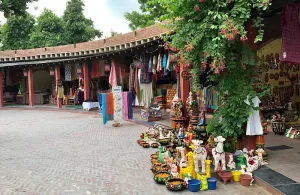
Humayun’s Tomb: Built-in 1565 A.D., the Humayun’s Tomb was established in the memory of Humayun by his widow Bega Begam, and was the first example of Mughal architecture in India. Constructed after nine years of his demise, the tomb is inspired by Persian architecture reflected in the corridors, arched alcoves, and the double dome. The tomb is also called chaharbagh, owing to its garden squares with passageways and water channels, and holds graves of Mughal rulers inside the walled enclosed space.
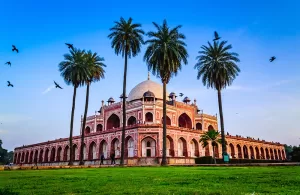
Lotus Temple: Known for its unique architectural design, Lotus Temple is a Bahá’í House of Worship dedicated to the harmony of humanity. Inspired by the lotus flower, the temple boasts 27 free-standing marble-clad petals and is surrounded by sprawling gardens and a pond. With a height of over 34 meters, it can accommodate around 2500 people altogether. The temple welcomes every religion symbolizing the culture of Bahá’í Houses of Worship, and offers a tranquil ambiance ideal for rejuvenation.

National Rail Museum: First of its kind in India, Delhi’s National Rail Museum houses the most extensive collection of life-size railway exhibits, including locomotives, coaches, and simulators collected from different princely states of the country. The indoor galleries within this 11-acre museum also preserve documents, drawings, books, maps, and other items that take you on a journey through over 160 years of the Indian Railway. Toy Train 1:8, 3D Virtual Coach Ride, Joy Train, and PSMT Ride are the major attractions at this museum.
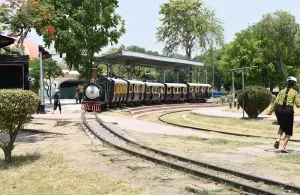
Jama Masjid: Located in the heart of Old Delhi, Jama Masjid is India’s largest and most well-known mosque. It was constructed between 1650 and 1656 under the reign of Mughal emperor Shah Jahan, and it took more than 5000 laborers to complete this extravagant structure. Built-in red sandstone and marble, this revered mosque has three gates, four towers, two 40-metre-high minarets and a courtyard holding 25,000 devotees. Please note that entry is not allowed in the mosque during prayers.
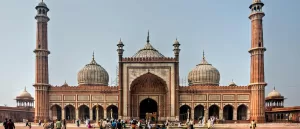
Jantar Mantar: Jantar Mantar is one of the most popular Delhi visiting places. This UNESCO World Heritage Site houses the equinoctial sundial that can measure the time of the day based on the sun’s movements. There are 13 astronomy architectural instruments here, and you can spend a couple of hours enjoying their precision and build.
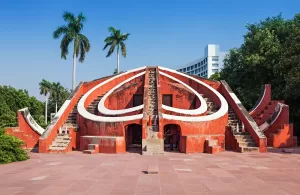
Agrasen ki Baoli: The Agrasen ki Baoli is a protected monument near Connaught Place. This deep stepwell has 108 steps and is said to have been built by the Agrawal community in the 14th century. You can spend up to an hour here marveling at the architectural brilliance, which counts among the top Delhi places to visit.

Chandni Chowk: Chandni Chowk is translated as Moonlight Street. This iconic area in Delhi houses one of the oldest markets in the city. You can buy everything you want at wholesale prices here. The hustle and bustle of the street, the colorful and quaint stores, and the constant banter between buyers and sellers are experiences you should not miss. Chandni Chowk has about 1500+ shops.

Lodhi Gardens: Lodhi Gardens is a park in the city spread over 90 acres and surrounded by a beautifully maintained landscape. It contains the tombs of Sikander Lodi, Mohammed Shah, Bara Gumbad, and Shisha Gumbad. The 15th-century architectural work is exquisite here. You can spend a few hours in the morning exploring the grounds.

Safdarjung’s Tomb: Safdarjung was the Nawab of Oudh and the Prime Minister of the Mughal Empire during the late 1940s. The Safdarjung Tomb is a monument made of sandstone and marble built after the death of the Nawab in 1754. A large podium and well-maintained grounds surround the Mausoleum in the center.

Raj Ghat: Raj Ghat is an important monument in Delhi and is dedicated to the Father of the Nation. It is located quite close to the river Yamuna and is the place where the last rites for Mahatma Gandhi was performed. The spot has an eternal flame burning and is open to the sky. It is a peaceful and very beautiful spot to visit.
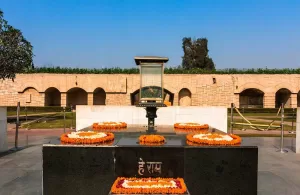
Chhatarpur Temple: Located in the South of Delhi in Chhatarpur, this is a Hindu temple dedicated to Goddess Katyayani. The temple was built in 1974 and is one of the largest temples in the world (spread across 70 acres). There are three large complexes and about 20 different shrines you can visit. The temple complex is beautiful in the evenings.

Gurudwara Bangla Sahib: The Gurudwara Bangla Sahib is not only one of the most prominent Sikh religious site, but also holds a place in the top Delhi tourist places list. Located near the Connaught Place, this gurudwara has a holy river name Sarovar inside its complex. This complex also houses a hospital, a library, a museum, and a higher secondary school.
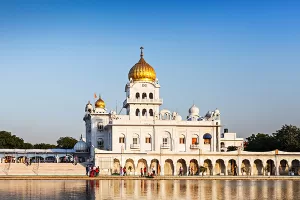
The Garden of Five Senses: The Garden of Five Senses was developed by the Delhi Tourism Transportation Development Corporation and is a beautiful leisure spot that locals and tourists love. The garden is located in the Said-Ul-Azaib village and is spectacular. Fountains, sky-high rocks, flowered pathways, water cascades, a Mughal garden, and stone and steel structures fill up the 20.5-acre area and delight the eyes.
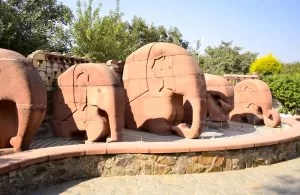
ISKCON Temple: The ISKCON Temple in Sant Nagar, Delhi, is one of the most famous temples visited by locals and tourists. The temple is the abode of Lord Krishna and has a beautiful complex you can spend a couple of hours in. The temple complex houses a Vedic study center and library, an ashram, and the Krishna Jayanti Park, complete with gardens, waterfalls, and ponds.

Purana Qila: The Purana Qila, also called the Old Fort, is one of the oldest forts in Delhi. Remains dating back to the Pre-Mauryan period were discovered here. The complex has three arched gateways and contains monuments like the Sher Mandal and the Qila-i-Kuhna mosque. Other historically important monuments can also be found around the Purana Qila.

Mehrauli Archaeological Park: The Mehrauli Archaeological Park is located adjacent to the Qutub Minar Complex and is spread over 200 acres. This park houses almost 100 archaeologically significant monuments, including the Tomb of Balban, Madhi Masjid, the Tomb of Quli Khan, and the Rajon Ki Baoli. It is easy to spend the whole day here exploring monuments if you are an archaeology enthusiast.
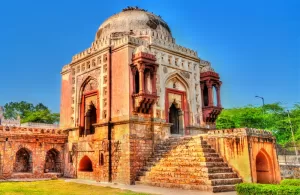
Birla Mandir: Dedicated to Laxminarayan, Birla Mandir, or Birla Temple, is one of the city’s most beautiful and revered Hindu temples. It was built in the 1900s by the Birla family and is located at Connaught Place. Apart from the idols of Lord Narayan and Goddess Laxmi, the temple houses the shrines of Lord Shiva, Lord Krishna, Lord Hanuman, Lord Buddha, and Goddess Durga. The 7.5-acre temple complex is accentuated with gardens, fountains, and sculptures, and there is Geeta Bhawan for discourses. The temple attracts thousands of devotees nationwide, especially on special occasions like Diwali and Janmashtami. Birla Mandir undoubtedly is one of the best places to visit in Delhi.

National Museum: Located on the corner of Janpath and Maulana Azad Road, National Museum is one of the most important museums in the country. This majestic building was inaugurated on 15th August 1949 and is maintained by the Ministry of Culture, Government of India. It possesses about 2,00,000 unique artworks of diverse nature, all depicting the rich cultural heritage of countries worldwide. Some works of art here cover a time span of over 5000 years! The museum is divided into different galleries, such as Harappan Gallery, Kushana Gallery, Gupta Gallery, and Buddhist Art Section, all worth exploring. It also has an auditorium where visitors can watch short films on art, history, and culture.

Tughlaqabad Fort: Built-in 1321 by the founder of the Tughlaq dynasty, Sultan Ghiyasuddin Tughlaq, Tughlaqabad Fort is counted among the most popular Delhi tourist places among historians and architecture lovers. This massive structure boasts high walls, monumental gateways, palaces, and a citadel. Tughlaqabad Fort is one of the finest examples of Islamic architecture.
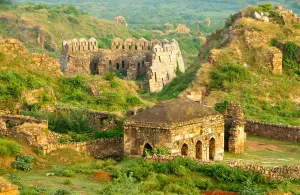
Southern Ridge Forest: Southern Ridge Forest is an attractive option for those looking to escape the city chaos and spend some time in natural surroundings. The forest is spread over 6200 hectares of land. It is particularly famous for housing the Asola Bhatti Wildlife Sanctuary, a biological habitat with different species of birds and animals. The sanctuary is home to about ten species of mammals, eight species of amphibians, 200 species of birds, ten species of reptiles, and 200 species of trees. Visitors can also spend quality time near Asola Lake and spot rare birds.
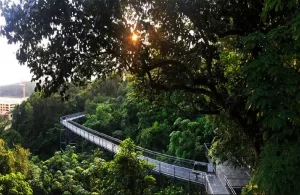
Places to visit near New Delhi
Damdama Lake: Situated almost 60 Km away from I.T.O. Delhi, Damdama Lake offers a splendid view of the Aravalli ranges and is perfect for day picnics. Famous for its serenity, t is amongst the largest natural lakes in Haryana and offers activities like para-sailing, hot air ballooning, rock climbing, camping and trekking. Besides, various resorts in the vicinity are ideal for a family getaway or corporate meetings.

Agra: Agra is located on the banks of river Yamuna in UP and is home to the world-renowned Taj Mahal. This monument of love is also one of the seven wonders of the world. There are many other monuments here that will give you a glimpse of the Mughal era. You can visit the old Meena Bazaar; the wood market will attract you the most.

Mathura and Vrindavan: The religious importance of Mathura and Vrindavan makes them unique. These two cities are great for some exploration, both spiritual and touristy. Mathura- the birthplace of Lord Krishna and Vrindavan- where Lord spent his childhood. There are many places to visit in the region.

Neemrana Fort-Palace: Located in Alwar, Neemrana Fort is a 15th-century palace converted into a heritage resort. An epitome of beauty and architecture, the fort palace is located among the hills of Aravali, the oldest fold mountains in the world. Today, the fort is a luxury resort where people can either book rooms or simply visit after paying an entrance fee. Earlier, Neemrana was under the reign of Rajput Maharaja Prithvi Raj Chauhan III. The fort was built in 1464 and became the third capital of the descendants of the king.
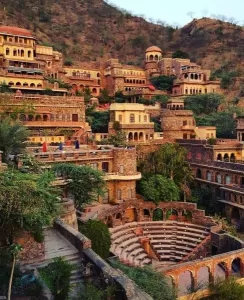
Sultanpur Bird Sanctuary: Sultanpur National Park is home to over 250 species of resident and migratory birds. Sultanpur Bird Sanctuary is located on Gurgaon-Farukh Nagar road, 40 km from Dhaula-Kuan in Delhi. Various species of migratory birds flock here after covering incredible distances from different parts of Europe, Siberia, and Central Asia.
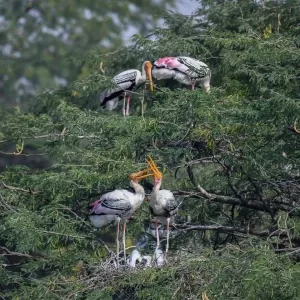
Sponsors




 ACODS 2024
ACODS 2024